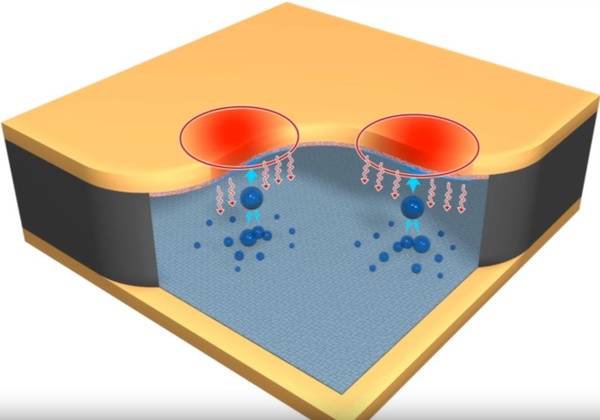|
engineers at duke university and intel have announced a new technology, based on the physical phenomenon that cleans the wings of cicadas, which uses water droplets jumping towards hotspots on high-powered electronics to provide cooling where it is needed most, according to a report on the duke website.

the vapor chamber created at duke university. (youtube)
the article explained, “when water droplets merge, the reduction in surface area causes the release of a small amount of energy. so long as the surface beneath is hydrophobic enough to repel water, this energy is sufficient to make the merged droplet jump away.”
to bring this phenomenon to electronics cooling, the engineers developed a vapor chamber with a super-hydrophobic floor and a sponge-like ceiling. “when placed beneath operating electronics, moisture trapped in the ceiling vaporizes beneath emerging hotspots,” the article continued. “the vapor escapes toward the floor, taking heat away from the electronics along with it.”
there are passive cooling structures in the floor to dissipate the heat and cause the vapor to condense into droplets. as the droplets merge, they jump off the floor and into the ceiling beneath a hotspot. the engineers added that this process occurs independent of gravity, so it will work if the vapor chamber is oriented upside down.
according to the article, this technology is a significant improvement on current cooling mechanisms because others lack the ability to target hotspots without additional power inputs and this method has built-in verticality unlike most heat spreaders.
duke associate professor chuan-hua chen said, “it has taken us a few years to work the system to a point where it’s at least comparable to a copper heat spreader, the most popular cooling solution,” said chen. “but now, for the first time, i see a pathway to beating the industry standards.”
the research was recently published in applied physics letters. the abstract stated:
“hotspot cooling is critical to the performance and reliability of electronic devices, but existing techniques are not very effective in managing mobile hotspots. we report a hotspot cooling technique based on a jumping-drop vapor chamber consisting of parallel plates of a superhydrophilic evaporator and a superhydrophobic condenser, where the working fluid is returned via the spontaneous out-of-plane jumping of condensate drops.
“while retaining the passive nature of traditional vapor-chamber heat spreaders (flat-plate heat pipes), the jumping-drop technique offers a mechanism to address mobile hotspots with a pathway toward effective thermal transport in the out-of-plane direction.”
see the jumping droplets in action in the video below:
|